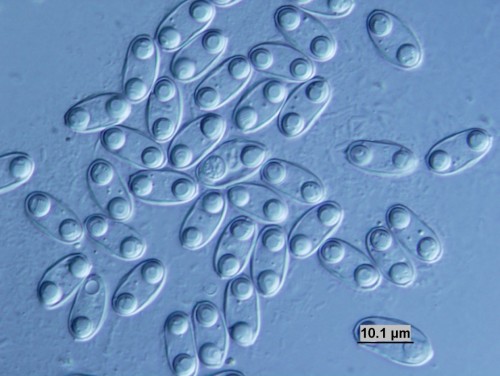An advanced genome test revealed that a microscopic parasite that lives in fish and belongs to the kingdom of protists, is an animal that evolved from the jellyfish family
The study was published this week in the journal PNAS

A team of researchers from Tel Aviv University and the University of Kansas applied next-generation gene sequencing technology to a strange microscopic parasite called myxozoa that lives in fish. The surprising conclusion: the creature is a close relative of the jellyfish, so there is no doubt that it is an animal from the tsorban family.
"The myxozoa is a strange creature, which has been a mystery to science until today," explains Prof. Dorothy Hoshon from the Department of Zoology at Tel Aviv University, who led the research in collaboration with researchers from the University of Kansas, from Harvard, from the National Aquaculture Center in Eilat and from CNRS in France. "In our research, we sequenced its genome and showed that it is a miniaturized version of an animal that we did not know until today, which apparently developed in an evolutionary process from the larger jellyfish. Our findings are a basis for rethinking the very question: What is an animal?"
The study was published this week in the journal PNAS.
Genome of a fungus
"The myxozoa intrigued us because of its strangeness," explains Prof. Hoshon. "It is composed of single cells, behaves like a single-celled parasite, and previously belonged to the kingdom of protists - creatures that are not animals, plants or fungi. Its external structure does not allow scientists to determine its evolutionary origin, so we asked to look at its genome - something that has recently become possible, thanks to next-generation gene sequencing technology."
The results were surprising: it turned out that the genome of the myxozoa is a reduced and offset version of the DNA of animals from the carnivorous system. It is particularly close to the polypodium jellyfish, which is a parasite of caviar eggs. "We discovered that the DNA of the myxozoa does not look like the DNA of an animal, but rather resembles the genome of a fungus," explains Prof. Hoshon. "It is 20 to 40 times smaller than the average genome of jellyfish, and it has only 20 million base pairs, compared to an average of about 300 million in known genomes from the tsorban family." More than that: basic components found in the DNA of all animals - mainly developmental genes, which participate in the creation of the body structure of the embryo - are missing in the genome of the myxozoa.
Still, the findings clearly proved that it was an animal, even if tiny and strange. According to Prof. Hoshon, "We found in myxozoa genes characteristic of jellyfish, which are responsible for building the sting cells used by the jellyfish to paralyze prey. Myxozoa also has such cells, and with them it attaches its spores to the host animal."
"An animal is usually defined as a multicellular and macroscopic creature, and the myxozoa does not meet these conditions," Prof. Hoshon concludes. "However, it evolved from the same evolutionary source as the jellyfish and other stingrays, so there is no doubt that it is an animal; A strange and 'censored' version of an animal - still an animal. Now we want to investigate how such a 'strange animal' species actually developed, and to find out if there are other creatures like it, which adopted a similar evolutionary strategy. In addition, we hope that the new knowledge about the myxozoa will help to develop drugs against these creatures, which cause enormous damage to the fish industry."

8 תגובות
https://www.facebook.com/willotus/posts/423231914381489
http://www.zo.utexas.edu/faculty/antisense/downloadfilestol.html
Meir, he doesn't have a nervous system, so the answer is no. Medusa too, although it has a nervous system, it does not have a real brain and therefore probably does not feel, certainly does not think and has consciousness. Today, the definition "animal" is accepted as a taxonomic definition and does not indicate the characteristics of the creature, if the myxozoa is in the same genetic lineage as the other animals, it should be defined as an animal.
Plants, bacteria and fungi also have DNA
If there is DNA, doesn't that mean it's an animal?
But plants also evolved from bacteria, so basically everything is animals.
I wonder if this animal "feels", "thinks", "has consciousness"
Creatures do not follow an evolutionary strategy, they are the result of evolution